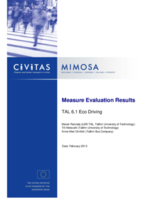Eco-driving training for bus drivers
Thematic areas
Behavioural change & mobility management
- Mobility marketing and awareness raising
- Mobility Planning
Summary
The city of Tallinn developed a training programme on energy-efficient driving for bus drivers to decrease fuel consumption and increase road safety. As a result of the improved driving style emission level and accident rate dropped and PT passenger comfort increased.
Implementing sustainable mobility
Eco-driving is a training used for improving drivers awareness of their driving behaviour and thus for improving their driving style. As a result of the improved driving style fuel consumption, emission levels and accident rate are reduced and PT passenger comfort is increased. Buses of the Tallinn Bus Company consume approximately 10 million litres of diesel a year. Every year buses are involved in approximately 100 accidents.
In the scope of the Tallinn MIMOSA measure 7 normal and 8 articulated buses were equipped with training equipment. 274 of the 666 drivers in the TBC were trained in 5 groups in the scope of the measure. 10 Tallinn Bus Company trainers were also trained in the scope of the measure.
The main objectives of the measure were to:
- Decrease fuel consumption of public transport vehicles;
- Raise awareness of eco-driving among bus drivers and their instructors;
- Increase safety for public transport users; and
- Reduce the number of accidents related to public transport.
Progress
The measure was implemented in the following stages:
Stage 1: Preparation for implementation of the measure, 2009-2010. Stage 2: Carrying out the public procurement procedures, 2010. Stage 3: Installing and testing the training equipment in the buses, 2010. Stage 4: Training and evaluation in 5 training groups, 2011-2012.
The innovative aspects of the measure are:
- Eco driving training with detailed real time feedback and later results analysis have not been done among Tallinn Bus Company or Tallinn bus drivers before;
- A modern technological solution – equipment and software for buses for carrying out eco driving training in Public Transport;
- Driving practice lessons during regular work servicing public city lines is a new approach compared to the training on a remote training site. Thus no costly driver or vehicle time was “wasted” for practicing lessons and evaluation.
The evaluation of the results was based on the actual fuel consumption measurements while servicing public city lines, measurements of the driving style index, traffic accident statistics and survey of bus drivers on awareness and acceptance. The emission change was derived from the fuel consumption data. A cost benefit analysis (CBA) was carried out, discounting benefits and costs over the whole project period 2010-2012, while the data for the 2012 was estimated. The costs included investments into the equipment and running costs, the benefits included fuel savings, emission savings and accident savings.
100% of the driving during the training was done during the regular work servicing the public city lines. This enabled to reduce the cost of the training since no drivers’ time or vehicle time was wasted. Also it enabled realistic evaluation of the training results in real life traffic and load conditions. The problematic driving events were recorded and visible for analysis for the trainer and drivers.
Outcomes
The results from the evaluation were: • Fuel consumption was reduced as a result of the eco driving training – the fuel consumption was reduced by 3,9% in average for the participants of the training and 0,9% total in the Tallinn Bus Company.
• The number of accidents involving a Tallinn Bus Company bus was reduced as a result of the eco driving training – the number of accidents was reduced by 22%.
• The amount of emissions was reduced as a result of the eco driving training – depending on the type of emission, the total Tallinn Bus Company annual amount was reduced by 0,7-1,0%.
• The driving style index was improved – the index was improved by 7,3% in average.
• The bus drivers awareness on the environment was improved - it was improved by 29%.
• The measure is highly cost-effective both socio-economically and financially – the CBA resulted in NPV 67 657€, B/C ratio 1,567 and IRR 620% in case of SDR 5,5%;
Since the running costs for the training are low (Tallinn Bus Company own trainers and there is no “wasted” driver and bus time) and the installed equipment has life expectancy up to 10 years, the result would be even better if longer period would be used for CBA.
The most important barrier was encountered during the running phase of the measure, however it did not influence the outcome considerably: • The rotation of bus drivers on the training-equipped buses created considerable amount of additional work for the traffic planners of the Tallinn Bus Company.
The following driver was encountered during running phase of the measure: • A quite remarkable competition came up by itself between the drivers being trained which helped to keep the driver motivation high.
Recommendations from the measure:• The measure should be easily replicable in any city given the fleet of the city is in accordance with technical requirements of the training equipment; • It is important to consider thoroughly the plan for driver-vehicle arrangement if only some buses are equipped for the training. • It is important to put effort into keeping bus drivers motivated in participating the training for getting the best possible results.








